This page was generated from notebooks/caveats.ipynb.
Interactive online version:
If any part of this notebook is used in your research, please cite with the reference found in README.md.
Caveats¶
Demonstrating known caveats and tweaks in spaghetti¶
Author: James D. Gaboardi jgaboardi@gmail.com
This notebook demonstrates the following limitations and caveats:
Limitations in non-planarity
Relaxing vertex coordinate precision
Distance matrices and shortest paths between (dis)connected components
Understanding network generation
[1]:
%config InlineBackend.figure_format = "retina"
[2]:
%load_ext watermark
%watermark
Last updated: 2022-11-01T23:06:20.324050-04:00
Python implementation: CPython
Python version : 3.10.6
IPython version : 8.6.0
Compiler : Clang 13.0.1
OS : Darwin
Release : 22.1.0
Machine : x86_64
Processor : i386
CPU cores : 8
Architecture: 64bit
[3]:
import geopandas
import libpysal
from libpysal.cg import Point, Chain
import matplotlib
import matplotlib.pyplot as plt
import numpy
import shapely
import spaghetti
%matplotlib inline
%watermark -w
%watermark -iv
Watermark: 2.3.1
geopandas : 0.12.1
shapely : 1.8.5.post1
numpy : 1.23.4
libpysal : 4.6.2
matplotlib: 3.6.1
spaghetti : 1.6.8
json : 2.0.9
/Users/the-gaboardi/miniconda3/envs/py310_spgh_dev/lib/python3.10/site-packages/spaghetti/network.py:39: FutureWarning: The next major release of pysal/spaghetti (2.0.0) will drop support for all ``libpysal.cg`` geometries. This change is a first step in refactoring ``spaghetti`` that is expected to result in dramatically reduced runtimes for network instantiation and operations. Users currently requiring network and point pattern input as ``libpysal.cg`` geometries should prepare for this simply by converting to ``shapely`` geometries.
warnings.warn(f"{dep_msg}", FutureWarning)
Helper functions for arc and vertex labeling¶
[4]:
def arc_labels(a, b, s, c="comp_label", offset=[-0.025, 0.025]):
"""Label each network arc."""
def _lab_loc(_x):
"""Helper for labeling network arcs."""
xy = _x.geometry.interpolate(0.5, normalized=True).coords[0]
xy = tuple([_xy+o for (_xy,o) in zip(xy,offset)])
return xy
kws = {"ha":"right", "va":"bottom","weight":"bold","color":"k","size":s}
a.apply(lambda x: b.annotate(text=x[c], xy=_lab_loc(x), **kws), axis=1)
def vert_labels(v, b, s, offset=[0.025, 0.025], col="comp_label", c="r"):
"""Label each network vertex."""
def _lab_loc(_x):
"""Internal helper for labeling vertices."""
xy = _x.geometry.coords[0]
xy = tuple([_xy+o for (_xy,o) in zip(xy,offset)])
return xy
kws = {"ha":"left", "va":"bottom","weight":"bold","color":c,"size":s}
v.apply(lambda x: b.annotate(text=x[col], xy=_lab_loc(x), **kws), axis=1)
1. Limitations in non-planarity¶
1.a — Barbed wire example¶
Create some line segments of libpysal.cg.Chain objects
[5]:
lines = [
Chain([Point((2,7)), Point((2,3))]),
Chain([Point((2,3)), Point((0,3))]),
Chain([Point((0,3)), Point((0,5))]),
Chain([Point((0,5)), Point((5,5))]),
Chain([Point((5,5)), Point((5,7))]),
Chain([Point((5,7)), Point((3,7))]),
Chain([Point((3,7)), Point((3,3))])
]
lines
[5]:
[<libpysal.cg.shapes.Chain at 0x1685f2500>,
<libpysal.cg.shapes.Chain at 0x1685f17e0>,
<libpysal.cg.shapes.Chain at 0x1685f2f20>,
<libpysal.cg.shapes.Chain at 0x1685f0d30>,
<libpysal.cg.shapes.Chain at 0x1685f0c10>,
<libpysal.cg.shapes.Chain at 0x1685f33a0>,
<libpysal.cg.shapes.Chain at 0x1685f2320>]
Instantiate a spaghetti.Network object
[6]:
ntw = spaghetti.Network(in_data=lines, extractgraph=False)
Extract the network vertices and arcs
[7]:
vertices_df, arcs_df = spaghetti.element_as_gdf(ntw, vertices=True, arcs=True)
vertices_df
[7]:
| id | geometry | comp_label | |
|---|---|---|---|
| 0 | 0 | POINT (2.00000 7.00000) | 0 |
| 1 | 1 | POINT (2.00000 3.00000) | 0 |
| 2 | 2 | POINT (0.00000 3.00000) | 0 |
| 3 | 3 | POINT (0.00000 5.00000) | 0 |
| 4 | 4 | POINT (5.00000 5.00000) | 0 |
| 5 | 5 | POINT (5.00000 7.00000) | 0 |
| 6 | 6 | POINT (3.00000 7.00000) | 0 |
| 7 | 7 | POINT (3.00000 3.00000) | 0 |
[8]:
arcs_df
[8]:
| id | geometry | comp_label | |
|---|---|---|---|
| 0 | (0, 1) | LINESTRING (2.00000 7.00000, 2.00000 3.00000) | 0 |
| 1 | (1, 2) | LINESTRING (2.00000 3.00000, 0.00000 3.00000) | 0 |
| 2 | (2, 3) | LINESTRING (0.00000 3.00000, 0.00000 5.00000) | 0 |
| 3 | (3, 4) | LINESTRING (0.00000 5.00000, 5.00000 5.00000) | 0 |
| 4 | (4, 5) | LINESTRING (5.00000 5.00000, 5.00000 7.00000) | 0 |
| 5 | (5, 6) | LINESTRING (5.00000 7.00000, 3.00000 7.00000) | 0 |
| 6 | (6, 7) | LINESTRING (3.00000 7.00000, 3.00000 3.00000) | 0 |
Plot
[9]:
base = arcs_df.plot(lw=3, color="k", alpha=.35, figsize=(9, 9))
vertices_df.plot(ax=base, fc="r", ec="k", markersize=50, zorder=2)
# vertex labels
vert_labels(vertices_df, base, 14)
vert_labels(vertices_df, base, 14, offset=[-0.15, 0.025], col="id", c="k")
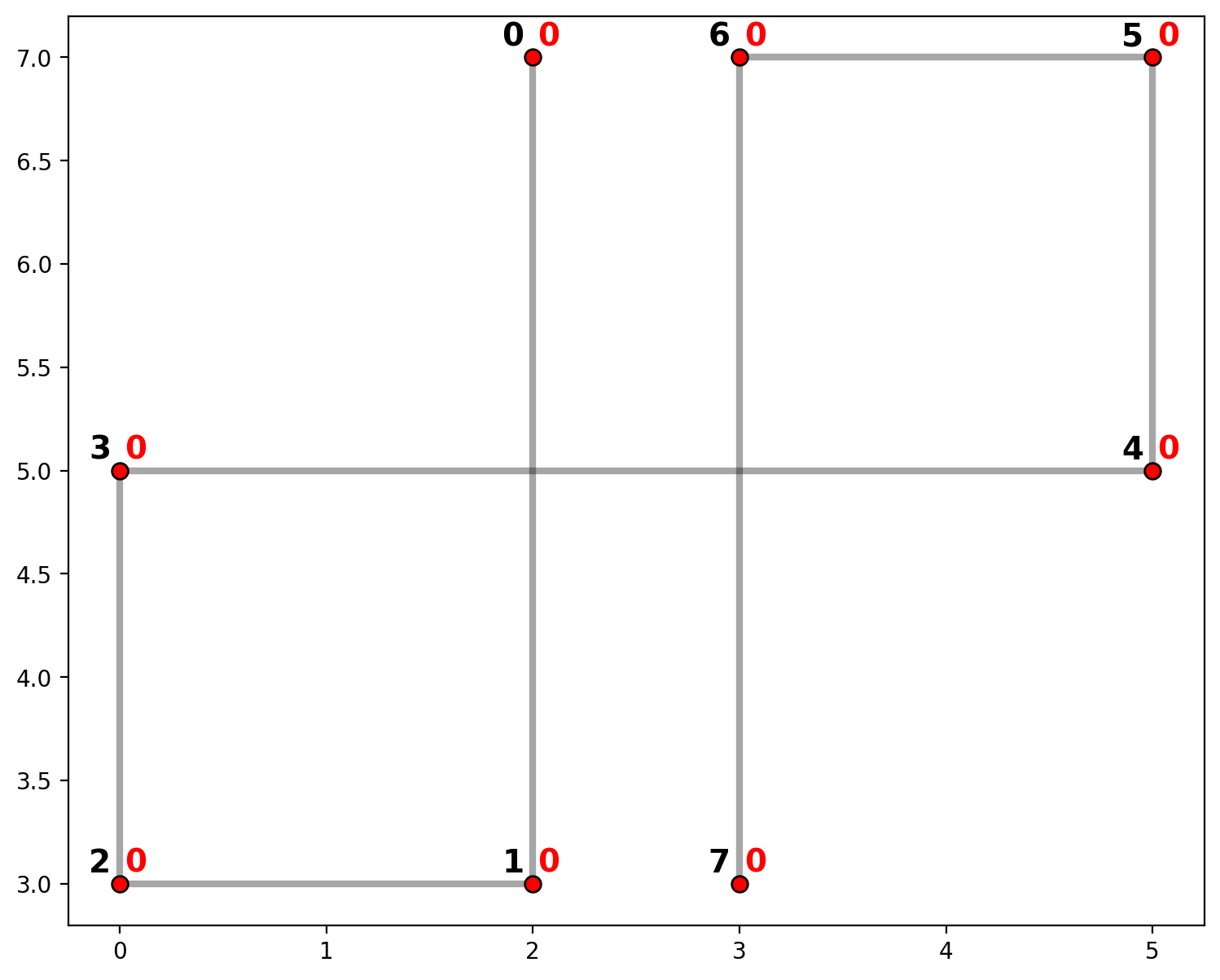
The plot above shows network arcs in gray with vertices in red. Also, vertices are labled in black and component membership is labeled in red. Since there are no actual intersections between segments (0,1),(3,4) or (3,4),(6,7), there are no vertices. Therefore, a shortest path from vertex 0 to 7 must follow the route {1,2,3,4,5,6} for a total of 21 units of distance.
[10]:
ntw.full_distance_matrix(n_processes=1, gen_tree=True)
[11]:
ntw.network_trees[0][7]
[11]:
[6, 5, 4, 3, 2, 1, 0]
[12]:
ntw.distance_matrix[0][7]
[12]:
21.0
1.b — Goalpost example¶
Create some line segments of libpysal.cg.Chain objects
[13]:
U = [Chain([Point((2,2)), Point((2,1)), Point((4,1)), Point((4,2))])]
I = [Chain([Point((3,0)), Point((3,1))])]
arcs = U + I
arcs
[13]:
[<libpysal.cg.shapes.Chain at 0x16877f640>,
<libpysal.cg.shapes.Chain at 0x1683ef670>]
Instantiate a spaghetti.Network object
[14]:
ntw = spaghetti.Network(in_data=arcs)
/Users/the-gaboardi/miniconda3/envs/py310_spgh_dev/lib/python3.10/site-packages/libpysal/weights/weights.py:172: UserWarning: The weights matrix is not fully connected:
There are 2 disconnected components.
There is 1 island with id: (4, 5).
warnings.warn(message)
/Users/the-gaboardi/miniconda3/envs/py310_spgh_dev/lib/python3.10/site-packages/libpysal/weights/weights.py:172: UserWarning: The weights matrix is not fully connected:
There are 2 disconnected components.
There are 2 islands with ids: (0, 3), (4, 5).
warnings.warn(message)
Examine the components
There are two components.
[15]:
ntw.network_n_components
[15]:
2
Component 0 includes 4 vertices (the “goal”) and component 1 includes 2 (the “post”).
[16]:
ntw.network_component_vertices
[16]:
{0: [0, 1, 2, 3], 1: [4, 5]}
Extract the network vertices and arcs
[17]:
vertices_df, arcs_df = spaghetti.element_as_gdf(ntw, vertices=True, arcs=True)
vertices_df
[17]:
| id | geometry | comp_label | |
|---|---|---|---|
| 0 | 0 | POINT (2.00000 2.00000) | 0 |
| 1 | 1 | POINT (2.00000 1.00000) | 0 |
| 2 | 2 | POINT (4.00000 1.00000) | 0 |
| 3 | 3 | POINT (4.00000 2.00000) | 0 |
| 4 | 4 | POINT (3.00000 0.00000) | 1 |
| 5 | 5 | POINT (3.00000 1.00000) | 1 |
[18]:
arcs_df
[18]:
| id | geometry | comp_label | |
|---|---|---|---|
| 0 | (0, 1) | LINESTRING (2.00000 2.00000, 2.00000 1.00000) | 0 |
| 1 | (1, 2) | LINESTRING (2.00000 1.00000, 4.00000 1.00000) | 0 |
| 2 | (2, 3) | LINESTRING (4.00000 1.00000, 4.00000 2.00000) | 0 |
| 3 | (4, 5) | LINESTRING (3.00000 0.00000, 3.00000 1.00000) | 1 |
Plot
[19]:
base_kws = {"alpha":.5, "lw":5, "cmap":"Paired", "column":"comp_label"}
base = arcs_df.plot(figsize=(9, 9), **base_kws)
vertices_df.plot(ax=base, fc="r", ec="k", markersize=50, zorder=2)
# vertex labels
vert_labels(vertices_df, base, 14)
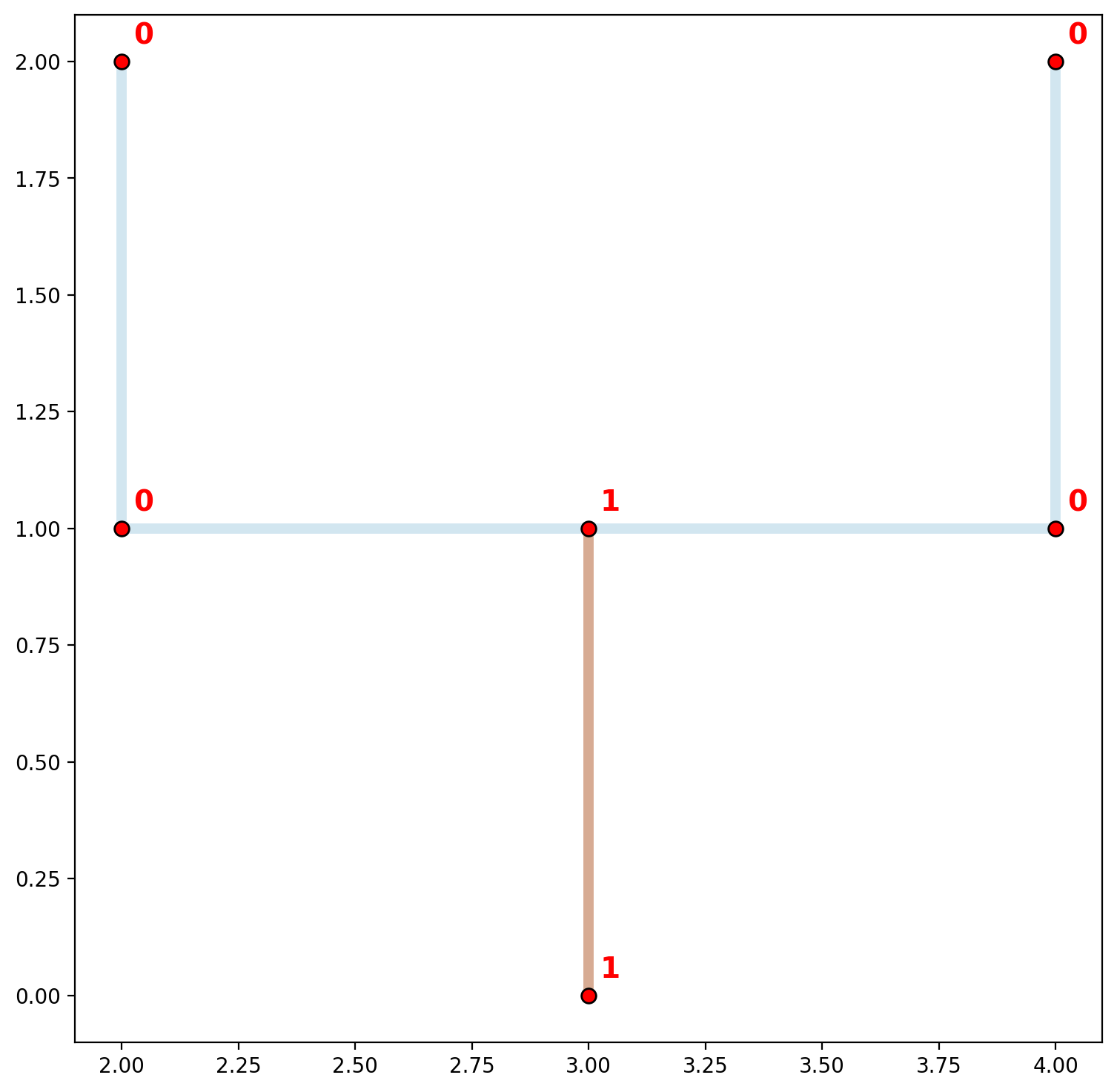
As stated previously, flow from one network segment to another is only possible when segments share a vertex. In this case, no vertex is actually shared, although superficially there does appear to be. The plot above visualizes this concept by showing the two (dis)connected components of the “goalpost” network. Network arcs are colored by component membership and vertices are labeled by component membership. This is also demonstrated below when overlaying a plot of libpysal.weights.W. This is accomplished below with arcs also shown with component membership (black nodes connected with black edges and labeled in black).
[20]:
base_kws = {"alpha":.5, "lw":5, "cmap":"Paired", "column":"comp_label"}
base = arcs_df.plot(figsize=(9, 9), zorder=0, **base_kws)
# plot keywords
node_kws, edge_kws = {"s":100, "zorder":2}, {"zorder":1}
w_kws = {"edge_kws":edge_kws, "node_kws":node_kws}
ntw.w_network.plot(arcs_df, indexed_on="id", ax=base, **w_kws)
vertices_df.plot(ax=base, fc="r", ec="k", markersize=50, zorder=2)
# arc labels
arc_labels(arcs_df, base, 12)
# vertex labels
vert_labels(vertices_df, base, 14)
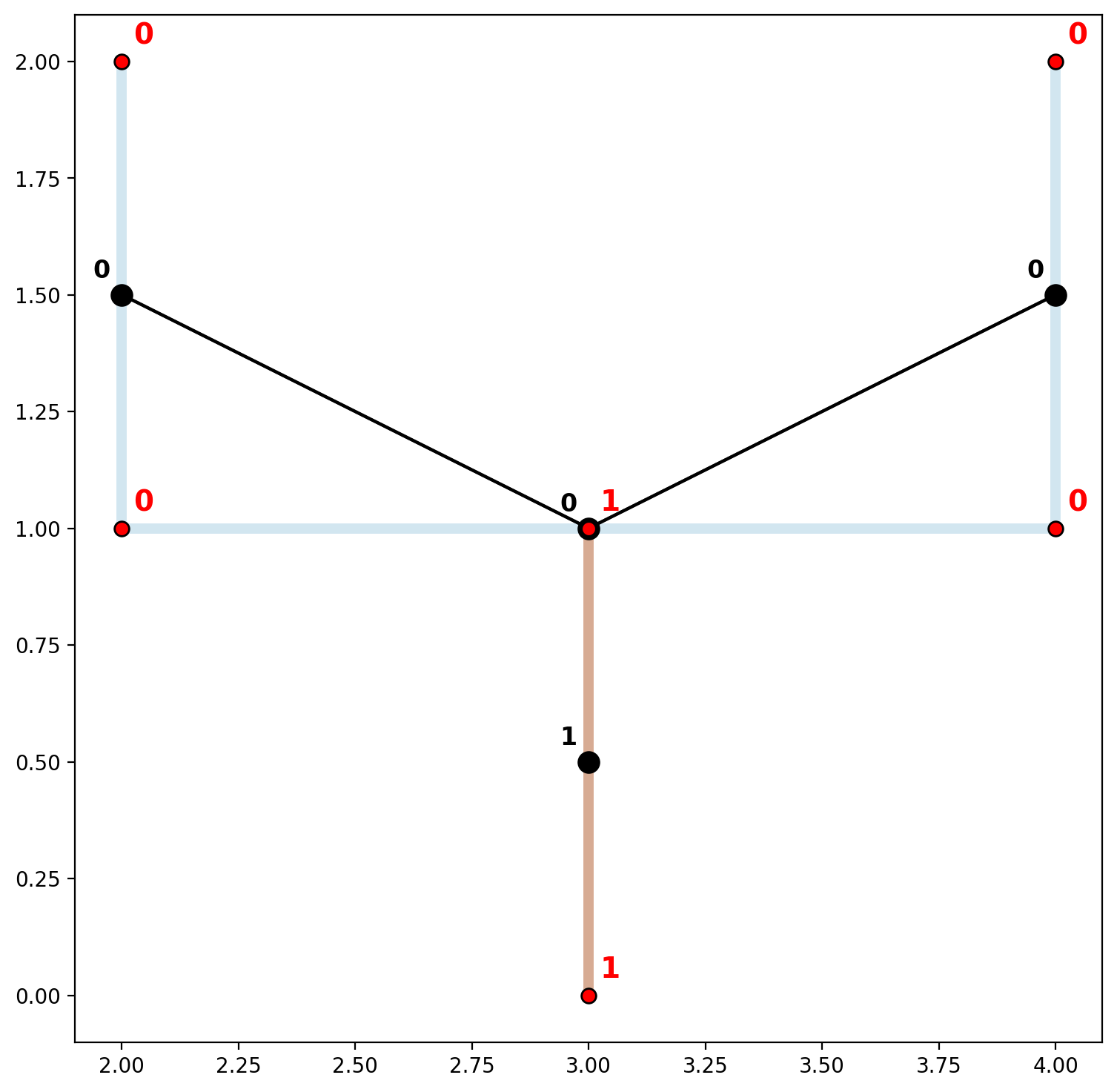
However, if the line segments were digitized “properly” a single connected component can be obtained (we emphasize “properly” because segments of a spatial network do not always intersect to form a single component in reality, for example highway over/underpases). In order to obtained a single connected component in this case we can simply add another point—(3,1)—to the initial collection of lines prior to network instantiation.
[21]:
U = [Chain([Point((2,2)), Point((2,1)), Point((3,1)), Point((4,1)), Point((4,2))])]
I = [Chain([Point((3,0)), Point((3,1))])]
arcs = U + I
ntw = spaghetti.Network(in_data=arcs)
print("Network components:\t", ntw.network_n_components)
print("Network vertices:\t", ntw.network_component_vertices)
vertices_df, arcs_df = spaghetti.element_as_gdf(ntw, vertices=True, arcs=True)
Network components: 1
Network vertices: {0: [0, 1, 2, 3, 4, 5]}
[22]:
base_kws = {"alpha":.5, "lw":5, "cmap":"Paired", "column":"comp_label"}
base = arcs_df.plot(figsize=(9, 9), zorder=0, **base_kws)
# plot keywords
node_kws, edge_kws = {"s":100, "zorder":2}, {"zorder":1}
w_kws = {"edge_kws":edge_kws, "node_kws":node_kws}
ntw.w_network.plot(arcs_df, indexed_on="id", ax=base, **w_kws)
vertices_df.plot(ax=base, fc="r", ec="k", markersize=50, zorder=2)
# arc labels
arc_labels(arcs_df, base, 12)
# vertex labels
vert_labels(vertices_df, base, 14)
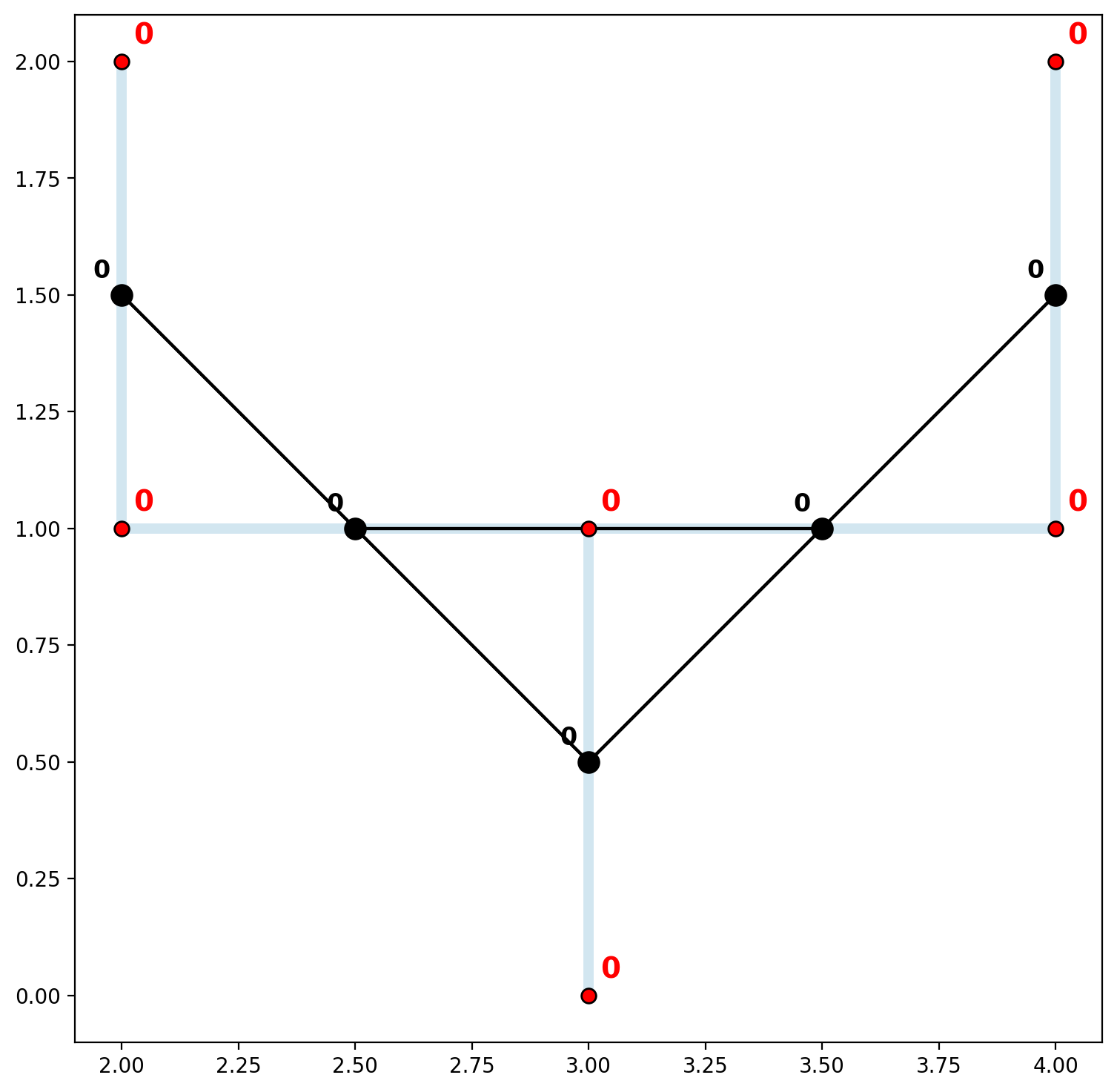
Now both the network vertices and spatially-weighted arcs are all members of a single connected component.
1.c — Empirical Example: John Snow’s Cholera Map¶
[23]:
libpysal.examples.explain("snow_maps")
snow_maps
=========
Public water pumps and Cholera deaths in London 1854 (John Snow's Cholera Map)
-----------------------------------------------------------------
* SohoPeople.dbf: attribute data for Cholera deaths. (k=2)
* SohoPeople.prj: ESRI projection file.
* SohoPeople.sbn: spatial index.
* SohoPeople.sbx: spatial index.
* SohoPeople.shp: Point shapefile for Cholera deaths. (n=324)
* SohoPeople.shx: spatial index.
* SohoWater.dbf: attribute data for public water pumps. (k=1)
* SohoWater.prj: ESRI projection file.
* SohoWater.sbn: spatial index.
* SohoWater.sbx: spatial index.
* SohoWater.shp: Point shapefile for public water pumps. (n=13)
* SohoWater.shx: spatial index.
* Soho_Network.dbf: attribute data for street network. (k=1)
* Soho_Network.prj: ESRI projection file.
* Soho_Network.sbn: spatial index.
* Soho_Network.sbx: spatial index.
* Soho_Network.shp: Line shapefile for street network. (n=118)
* Soho_Network.shx: spatial index.
Original data: Snow, J. (1849). On the Mode of Communication of Cholera. London: John Churchill, New Burlington Street.
[24]:
soho = geopandas.read_file(libpysal.examples.get_path("Soho_Network.shp"))
soho = soho.to_crs(epsg=32630)
soho
[24]:
| Id | geometry | |
|---|---|---|
| 0 | 0 | LINESTRING (698394.862 5710772.742, 698230.823... |
| 1 | 0 | LINESTRING (698373.590 5710607.200, 698481.244... |
| 2 | 0 | LINESTRING (698466.845 5710652.970, 698381.993... |
| 3 | 0 | LINESTRING (698373.590 5710607.200, 698322.058... |
| 4 | 0 | LINESTRING (698322.058 5710573.561, 698304.893... |
| ... | ... | ... |
| 113 | 0 | LINESTRING (698851.874 5710691.953, 698837.518... |
| 114 | 0 | LINESTRING (698860.680 5710803.234, 698825.980... |
| 115 | 0 | LINESTRING (698748.567 5710903.073, 698703.656... |
| 116 | 0 | LINESTRING (698715.115 5710881.223, 698695.567... |
| 117 | 0 | LINESTRING (698673.506 5710931.132, 698695.567... |
118 rows × 2 columns
[25]:
ntw = spaghetti.Network(in_data=soho)
/Users/the-gaboardi/miniconda3/envs/py310_spgh_dev/lib/python3.10/site-packages/libpysal/weights/weights.py:172: UserWarning: The weights matrix is not fully connected:
There are 45 disconnected components.
There are 24 islands with ids: (22, 23), (28, 29), (30, 31), (47, 48), (49, 50), (58, 59), (67, 68), (75, 76), (84, 85), (86, 87), (108, 109), (110, 111), (121, 122), (128, 129), (172, 173), (183, 184), (185, 186), (190, 191), (208, 209), (212, 213), (216, 217), (218, 219), (220, 221), (222, 223).
warnings.warn(message)
/Users/the-gaboardi/miniconda3/envs/py310_spgh_dev/lib/python3.10/site-packages/libpysal/weights/weights.py:172: UserWarning: The weights matrix is not fully connected:
There are 45 disconnected components.
There are 37 islands with ids: (5, 149), (22, 23), (24, 27), (28, 29), (30, 31), (47, 48), (49, 50), (58, 59), (67, 68), (72, 74), (75, 76), (84, 85), (86, 87), (89, 90), (108, 109), (110, 111), (121, 122), (124, 127), (128, 129), (150, 152), (153, 155), (163, 215), (165, 211), (168, 170), (172, 173), (183, 184), (185, 186), (190, 191), (193, 195), (197, 199), (208, 209), (212, 213), (216, 217), (218, 219), (220, 221), (222, 223), (224, 226).
warnings.warn(message)
[26]:
ntw.network_n_components
[26]:
45
[27]:
vertices_df, arcs_df = spaghetti.element_as_gdf(ntw, vertices=True, arcs=True)
base_kws = {"alpha":.5, "lw":5, "cmap":"Paired", "column":"comp_label"}
base = arcs_df.plot(figsize=(12, 12), **base_kws)
vertices_df.plot(ax=base, fc="r", ec="k", markersize=50, zorder=2)
[27]:
<AxesSubplot: >
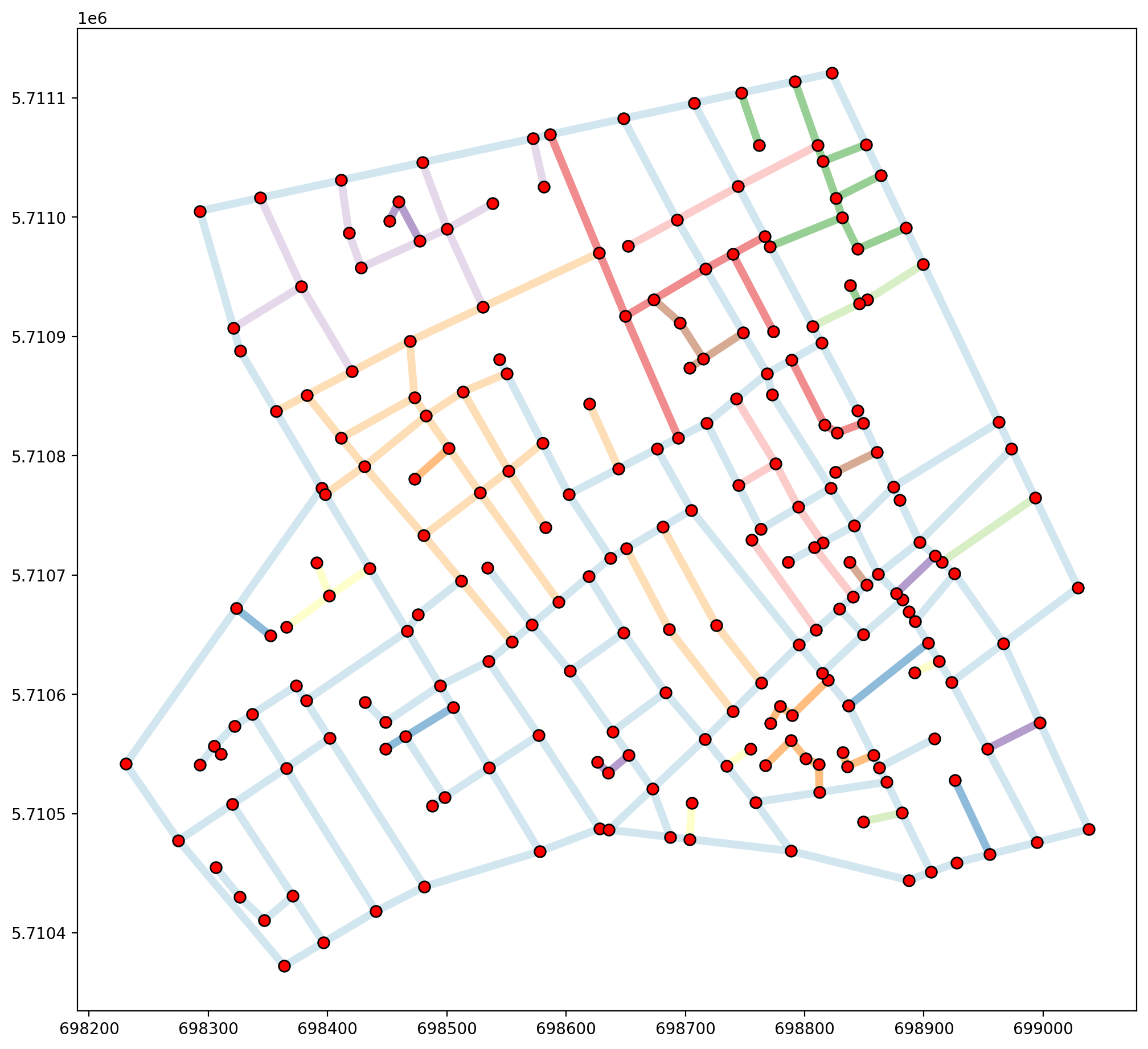
In this dataset that are 45 components of the networks, indicating some serious issues with intended connectivity. When overlayed with arc spatial weights it becomes clear that many of the arcs that appear to (and should) intersect, actually do not.
[28]:
base_kws = {"alpha":.5, "lw":5, "cmap":"Paired", "column":"comp_label"}
base = arcs_df.plot(figsize=(12, 12), zorder=0, **base_kws)
# plot keywords
node_kws, edge_kws = {"s":100, "zorder":2}, {"zorder":1}
w_kws = {"edge_kws":edge_kws, "node_kws":node_kws}
ntw.w_network.plot(arcs_df, indexed_on="id", ax=base, **w_kws)
vertices_df.plot(ax=base, fc="r", ec="k", markersize=50, zorder=2);
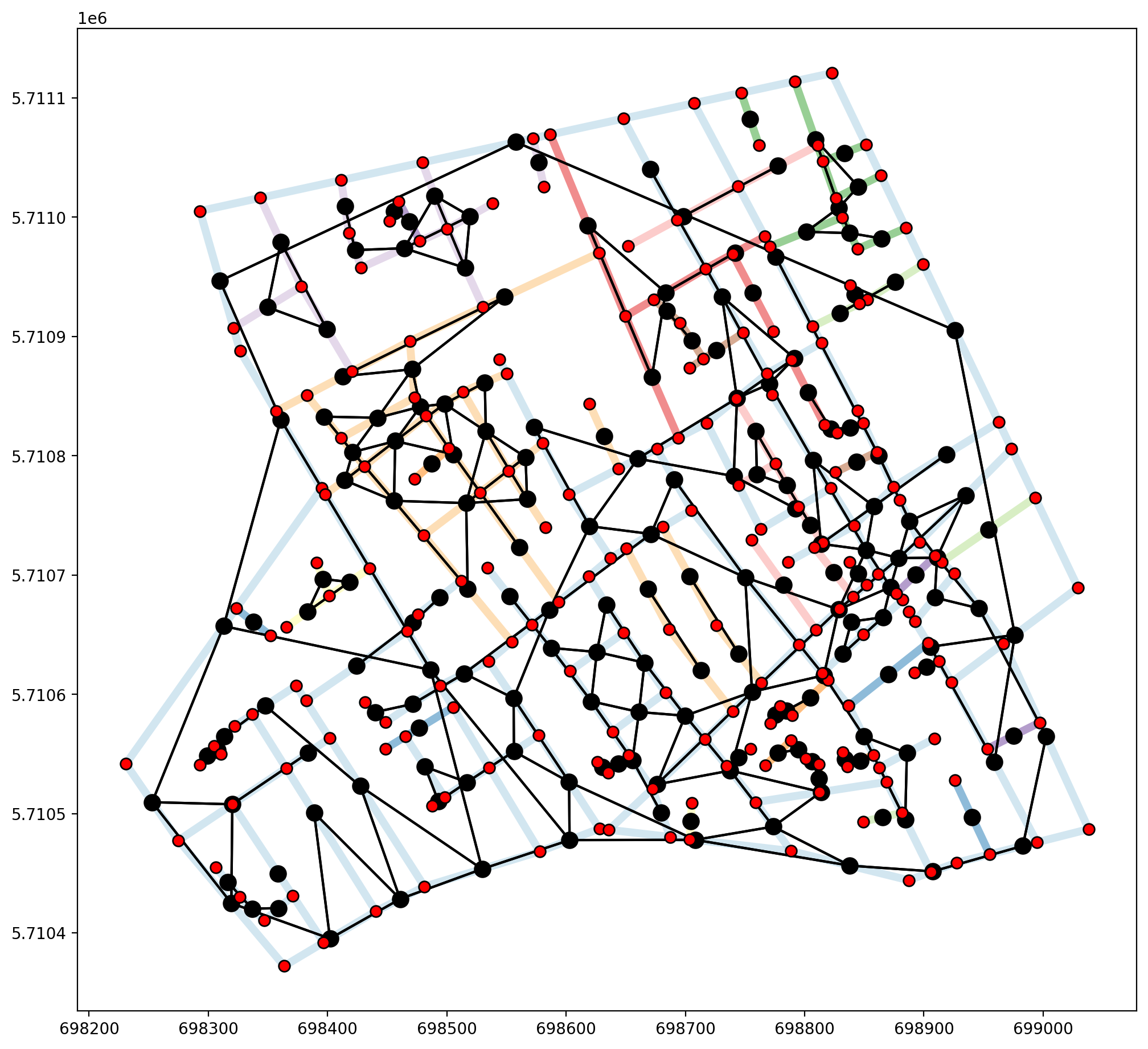
Fuzzy contiguity can be acheived through libpysal.weights.fuzzy_contiguity(), which provides us with a single connected component, but does not capture the true nature of the network stucture, as demonstrated below.
[29]:
fuzzy = libpysal.weights.fuzzy_contiguity(arcs_df)
fuzzy.remap_ids(arcs_df.id)
fuzzy.n_components
/Users/the-gaboardi/miniconda3/envs/py310_spgh_dev/lib/python3.10/site-packages/libpysal/weights/weights.py:172: UserWarning: The weights matrix is not fully connected:
There are 19 disconnected components.
There are 11 islands with ids: 30, 31, 60, 73, 81, 111, 156, 166, 181, 183, 185.
warnings.warn(message)
[29]:
19
[30]:
base_kws = {"alpha":.5, "lw":5, "cmap":"Paired", "column":"comp_label"}
base = arcs_df.plot(figsize=(12, 12), zorder=0, **base_kws)
# plot keywords
node_kws, edge_kws = {"s":100, "zorder":2}, {"zorder":1}
w_kws = {"edge_kws":edge_kws, "node_kws":node_kws}
fuzzy.plot(arcs_df, indexed_on="id", ax=base, **w_kws)
vertices_df.plot(ax=base, fc="r", ec="k", markersize=50, zorder=2);
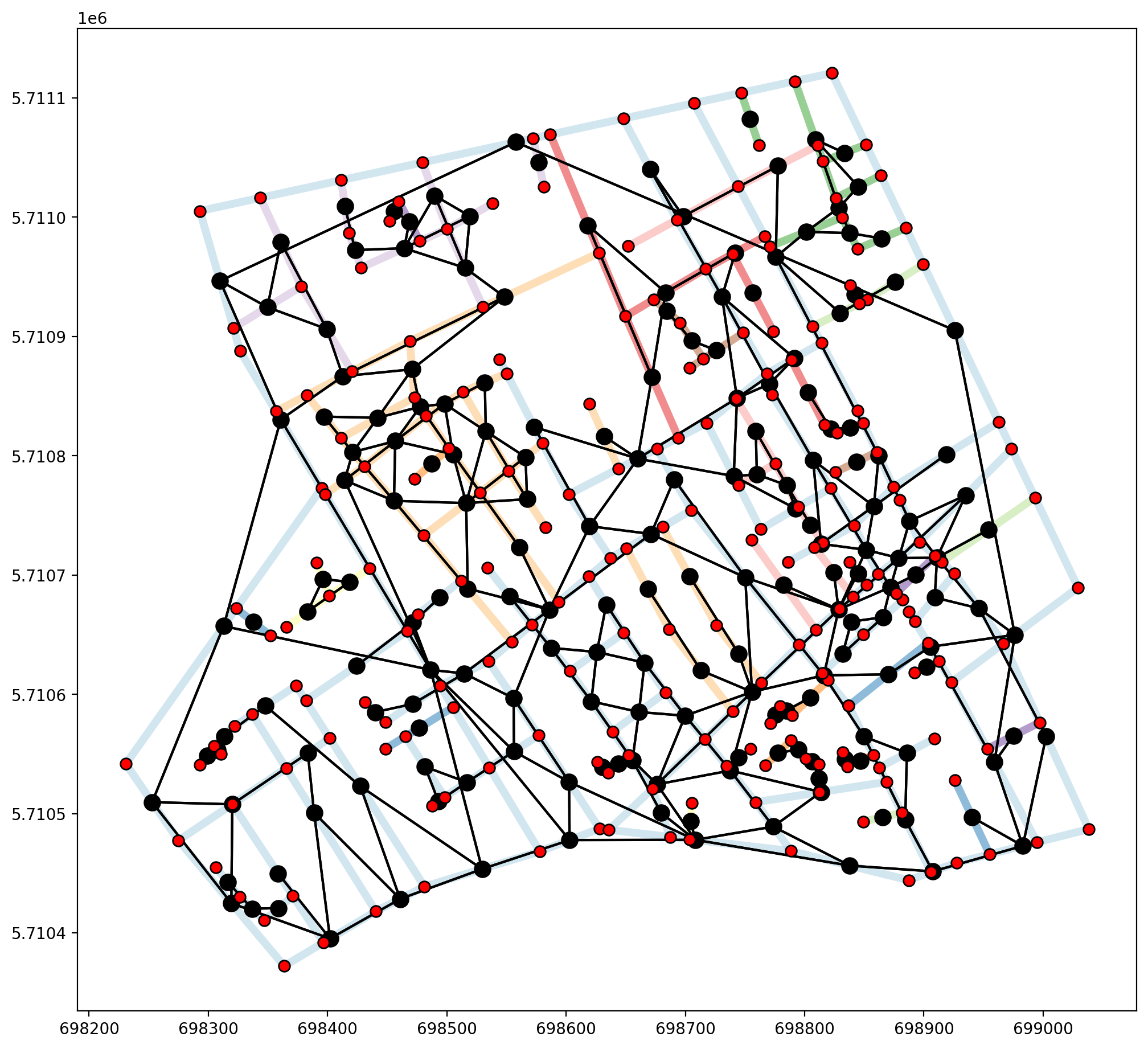
The issue with the Soho_Network.shp dataset is not precision, it is that not all true intersections are demarcated with vertices, as in the “goalpost” example above. This is clearly seen in the upper two segments of the network exterior where each segment is a single object, not broken at joining segments. In order to properly use the Soho_Network.shp dataset as a network, geometric preprocessing would need to be
performed in order to extract all intersections.
2. Precision limitations and/or known issues with digitization¶
Revisting the “goalpost” network — Slightly imprecise coordinates¶
Here the “I” of the goalpost has been digitized slightly short of the intersection with the “U” component.
[31]:
U = [Chain([Point((2,2)), Point((2,1)), Point((3,1)), Point((4,1)), Point((4,2))])]
I = [Chain([Point((3,0)), Point((3,0.99999))])]
arcs = U + I
ntw = spaghetti.Network(in_data=arcs)
print("Network components:\t", ntw.network_n_components)
print("Network vertices:\t", ntw.network_component_vertices)
vertices_df, arcs_df = spaghetti.element_as_gdf(ntw, vertices=True, arcs=True)
Network components: 2
Network vertices: {0: [0, 1, 2, 3, 4], 1: [5, 6]}
/Users/the-gaboardi/miniconda3/envs/py310_spgh_dev/lib/python3.10/site-packages/libpysal/weights/weights.py:172: UserWarning: The weights matrix is not fully connected:
There are 2 disconnected components.
There is 1 island with id: (5, 6).
warnings.warn(message)
/Users/the-gaboardi/miniconda3/envs/py310_spgh_dev/lib/python3.10/site-packages/libpysal/weights/weights.py:172: UserWarning: The weights matrix is not fully connected:
There are 2 disconnected components.
There are 2 islands with ids: (0, 4), (5, 6).
warnings.warn(message)
[32]:
base_kws = {"alpha":.5, "lw":5, "cmap":"Paired", "column":"comp_label"}
base = arcs_df.plot(figsize=(9, 9), zorder=0, **base_kws)
# plot keywords
node_kws, edge_kws = {"s":100, "zorder":2}, {"zorder":1}
w_kws = {"edge_kws":edge_kws, "node_kws":node_kws}
ntw.w_network.plot(arcs_df, indexed_on="id", ax=base, **w_kws)
vertices_df.plot(ax=base, fc="r", ec="k", markersize=50, zorder=2)
plt.xlim(2.9999, 3.0001)
plt.ylim(0.9999, 1.0001);
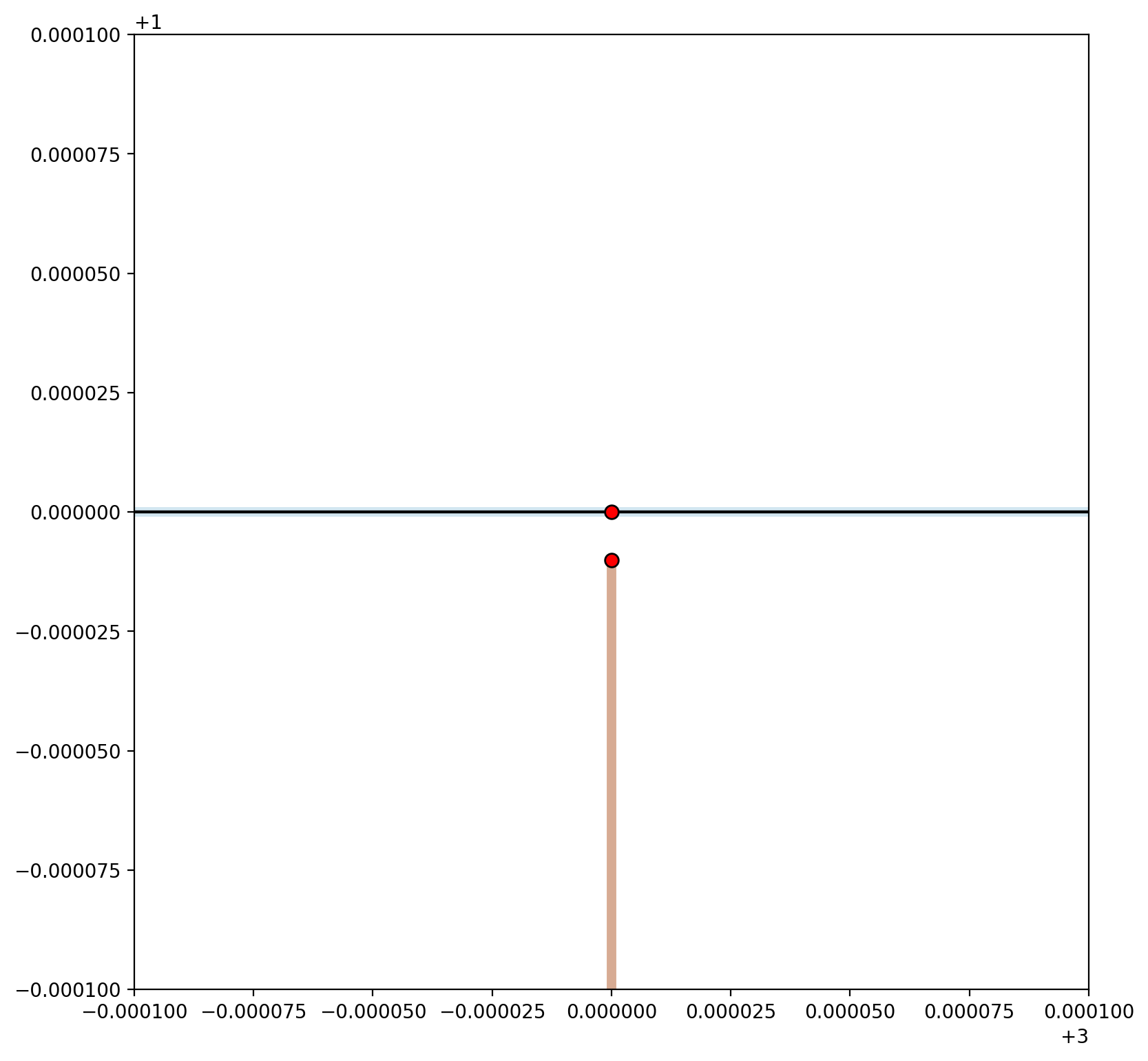
A small gap is shown in the plot above resulting in two network components.
[33]:
base_kws = {"alpha":.5, "lw":5, "cmap":"Paired", "column":"comp_label"}
base = arcs_df.plot(figsize=(9, 9), zorder=0, **base_kws)
# plot keywords
node_kws, edge_kws = {"s":100, "zorder":2}, {"zorder":1}
w_kws = {"edge_kws":edge_kws, "node_kws":node_kws}
ntw.w_network.plot(arcs_df, indexed_on="id", ax=base, **w_kws)
vertices_df.plot(ax=base, fc="r", ec="k", markersize=50, zorder=2)
# arc labels
arc_labels(arcs_df, base, 12)
# vertex labels
vert_labels(vertices_df, base, 14)
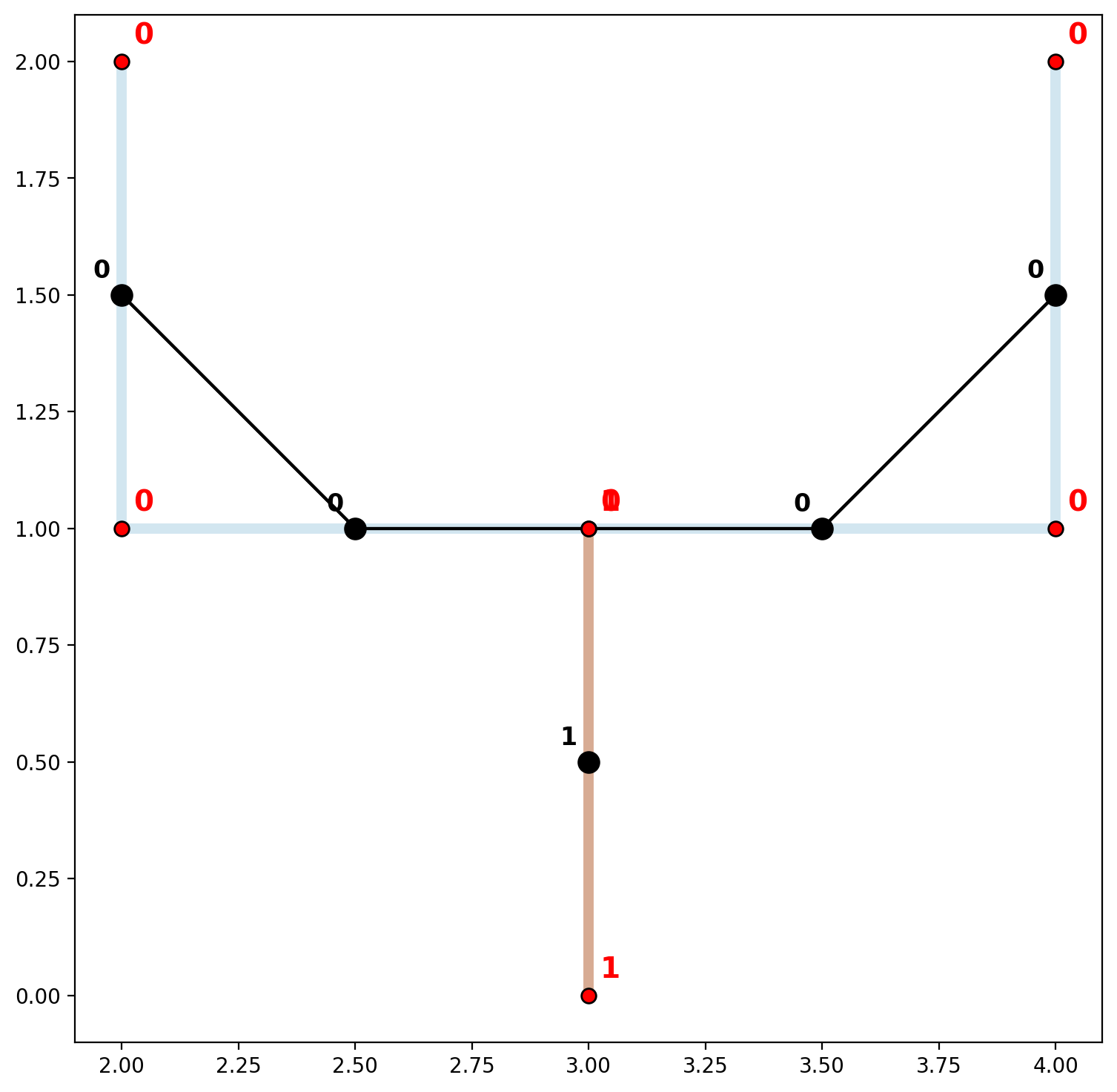
In order to accomodate situations like these where network elements are digitized in generally the correct locations but the precision is lacking, the vertex_atol parameter can be invoked when instantiating the network. This parameter allows for the rounding of decimal places (not significant digits — see vertex_sig), but should be used with caution.
[34]:
ntw = spaghetti.Network(in_data=arcs, vertex_atol=3)
print("Network components:\t", ntw.network_n_components)
print("Network vertices:\t", ntw.network_component_vertices)
vertices_df, arcs_df = spaghetti.element_as_gdf(ntw, vertices=True, arcs=True)
Network components: 1
Network vertices: {0: [0, 1, 2, 3, 4, 5]}
[35]:
base_kws = {"alpha":.5, "lw":5, "cmap":"Paired", "column":"comp_label"}
base = arcs_df.plot(figsize=(9, 9), zorder=0, **base_kws)
# plot keywords
node_kws, edge_kws = {"s":100, "zorder":2}, {"zorder":1}
w_kws = {"edge_kws":edge_kws, "node_kws":node_kws}
ntw.w_network.plot(arcs_df, indexed_on="id", ax=base, **w_kws)
vertices_df.plot(ax=base, fc="r", ec="k", markersize=50, zorder=2)
# arc labels
arc_labels(arcs_df, base, 12)
# vertex labels
vert_labels(vertices_df, base, 14)
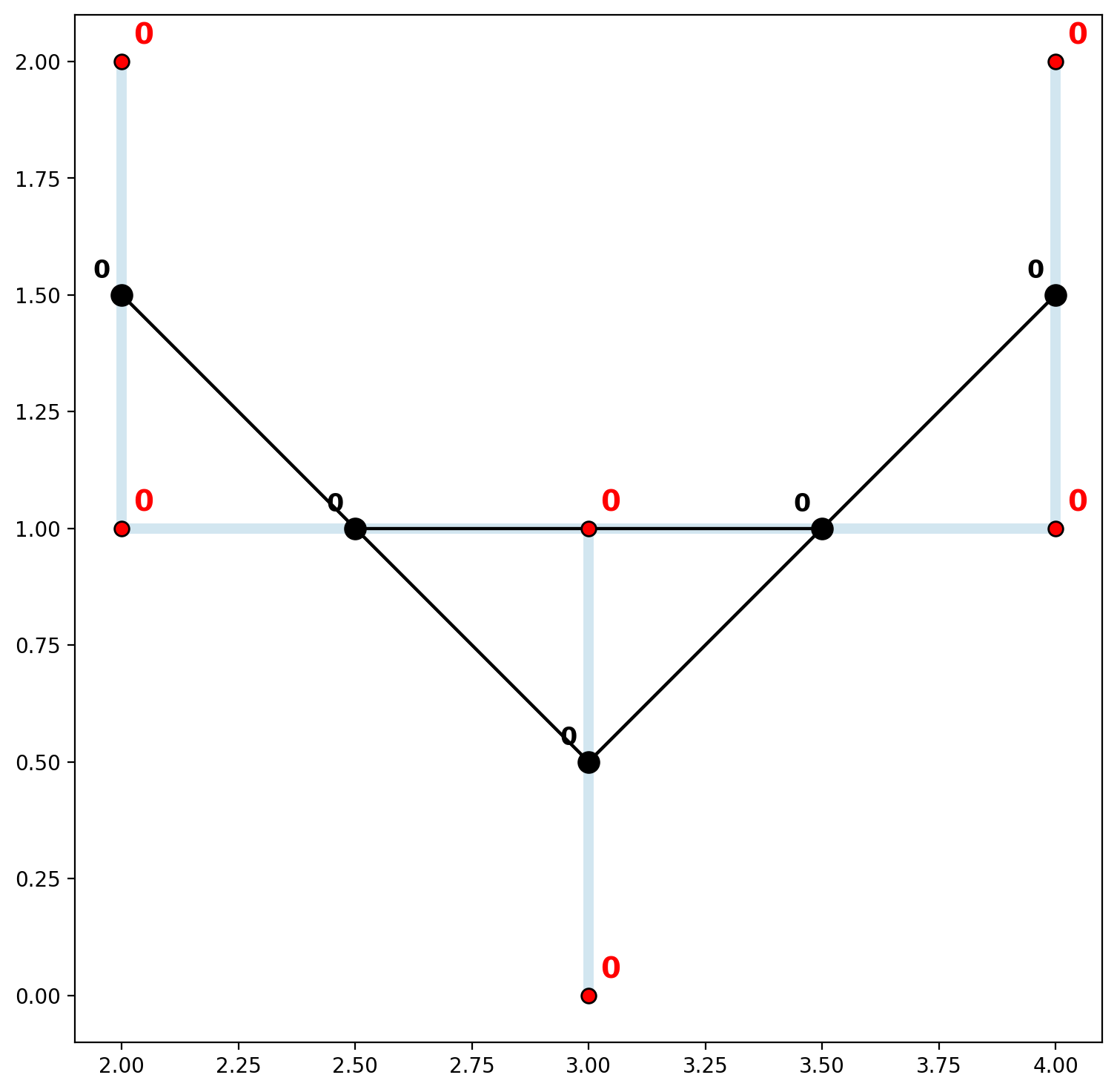
3. Distance matrices and shortest paths for multiple connected components¶
Continuing with the original “goalpost” network comprised of 2 components¶
[36]:
U = [Chain([Point((2,2)), Point((2,1)), Point((4,1)), Point((4,2))])]
I = [Chain([Point((3,0)), Point((3,1))])]
arcs = U + I
ntw = spaghetti.Network(in_data=arcs)
ntw.full_distance_matrix(n_processes=1, gen_tree=True)
/Users/the-gaboardi/miniconda3/envs/py310_spgh_dev/lib/python3.10/site-packages/libpysal/weights/weights.py:172: UserWarning: The weights matrix is not fully connected:
There are 2 disconnected components.
There is 1 island with id: (4, 5).
warnings.warn(message)
/Users/the-gaboardi/miniconda3/envs/py310_spgh_dev/lib/python3.10/site-packages/libpysal/weights/weights.py:172: UserWarning: The weights matrix is not fully connected:
There are 2 disconnected components.
There are 2 islands with ids: (0, 3), (4, 5).
warnings.warn(message)
[37]:
ntw.network_component_vertices
[37]:
{0: [0, 1, 2, 3], 1: [4, 5]}
[38]:
ntw.distance_matrix
[38]:
array([[ 0., 1., 3., 4., inf, inf],
[ 1., 0., 2., 3., inf, inf],
[ 3., 2., 0., 1., inf, inf],
[ 4., 3., 1., 0., inf, inf],
[inf, inf, inf, inf, 0., 1.],
[inf, inf, inf, inf, 1., 0.]])
From vertex 0 only vertices {1,2,3} can be reached. This is shown in the distance matrix by inf values in the 4th and 5th columns, and by identical origin-destination shortest paths in the network trees.
[39]:
ntw.distance_matrix[0]
[39]:
array([ 0., 1., 3., 4., inf, inf])
[40]:
ntw.network_trees[0]
[40]:
{0: [0], 1: [0], 2: [1, 0], 3: [2, 1, 0], 4: [4], 5: [5]}
Like the example in cell 21 above, by inserting a vertex complete network connectivity can be achieved.
[41]:
U = [Chain([Point((2,2)), Point((2,1)), Point((3,1)), Point((4,1)), Point((4,2))])]
I = [Chain([Point((3,0)), Point((3,1))])]
arcs = U + I
ntw = spaghetti.Network(in_data=arcs)
ntw.full_distance_matrix(n_processes=1, gen_tree=True)
[42]:
ntw.network_component_vertices
[42]:
{0: [0, 1, 2, 3, 4, 5]}
[43]:
ntw.distance_matrix
[43]:
array([[0., 1., 2., 3., 4., 3.],
[1., 0., 1., 2., 3., 2.],
[2., 1., 0., 1., 2., 1.],
[3., 2., 1., 0., 1., 2.],
[4., 3., 2., 1., 0., 3.],
[3., 2., 1., 2., 3., 0.]])
[44]:
ntw.distance_matrix[0]
[44]:
array([0., 1., 2., 3., 4., 3.])
[45]:
ntw.network_trees[0]
[45]:
{0: [0], 1: [0], 2: [1, 0], 3: [2, 1, 0], 4: [3, 2, 1, 0], 5: [2, 1, 0]}
4. Understanding network generation¶
Why does the spaghetti.Network object have so many vertices?¶
The core procedure for generating network representations is performed within the internal spaghetti.Network._extractnetwork() method. Here it is important to note that a spaghetti.Network instance is built up from the individual, constituent euclidean units of each line segment object. Therefore, the resulting network structure will generally have: 1. More vertices and links than may expected, and; 2. Many degree-2 vertices, which differs from a truly graph-theoretic object.
This is demonstrated below with a sinuous line.
[46]:
def sine_chain(npts):
"""Create a sine line."""
xs = numpy.linspace(1, 10, npts)
xys = zip(xs, numpy.sin(xs))
pts = [Point((x, y)) for (x, y) in xys]
chain = Chain(pts)
return chain
def sine_linestring_gdf(in_df, drop_col="id", dissolve_by="comp_label"):
"""Merge all line segments into a single line segment."""
out_df = in_df.copy()
out_df = out_df.dissolve(by=dissolve_by)
out_df.reset_index(drop=True, inplace=True)
out_df.drop(columns=drop_col, inplace=True)
return out_df
Create a sine line
[47]:
sine_points = 40
ntw = spaghetti.Network(in_data=sine_chain(sine_points))
vertices_df, arcs_df = spaghetti.element_as_gdf(ntw, vertices=True, arcs=True)
base = arcs_df.plot(lw=3, color="k", alpha=.35, figsize=(15, 5))
vertices_df.plot(ax=base, fc="r", ec="k", markersize=50, zorder=2)
# vertex labels
vert_labels(vertices_df, base, 14, col="id", c="k")
plt.axis("off");

Here we can see there are 40 vertices and 39 links in the network structure, not a single link with two endpoint vertices.
[48]:
arcs_df.head()
[48]:
| id | geometry | comp_label | |
|---|---|---|---|
| 0 | (0, 1) | LINESTRING (1.00000 0.84147, 1.23077 0.94275) | 0 |
| 1 | (1, 2) | LINESTRING (1.23077 0.94275, 1.46154 0.99404) | 0 |
| 2 | (2, 3) | LINESTRING (1.46154 0.99404, 1.69231 0.99263) | 0 |
| 3 | (3, 4) | LINESTRING (1.69231 0.99263, 1.92308 0.93859) | 0 |
| 4 | (4, 5) | LINESTRING (1.92308 0.93859, 2.15385 0.83479) | 0 |
[49]:
arcs_df.tail()
[49]:
| id | geometry | comp_label | |
|---|---|---|---|
| 34 | (34, 35) | LINESTRING (8.84615 0.54687, 9.07692 0.34088) | 0 |
| 35 | (35, 36) | LINESTRING (9.07692 0.34088, 9.30769 0.11682) | 0 |
| 36 | (36, 37) | LINESTRING (9.30769 0.11682, 9.53846 -0.11344) | 0 |
| 37 | (37, 38) | LINESTRING (9.53846 -0.11344, 9.76923 -0.33768) | 0 |
| 38 | (38, 39) | LINESTRING (9.76923 -0.33768, 10.00000 -0.54402) | 0 |
However, the set of network links can be dissolved into a single linestring with two endpoints.
[50]:
sine_df = sine_linestring_gdf(arcs_df)
sine_endpoints = sine_df.geometry.squeeze().boundary
sine_verts = geopandas.GeoDataFrame(geometry=[sine_endpoints])
base = sine_df.plot(lw=3, color="k", alpha=.35, figsize=(15, 5))
sine_verts.plot(ax=base, fc="r", ec="k", markersize=50, zorder=2)
plt.axis("off");

But if the singular sine line is used to instantiate a new network it is broken out again.
[51]:
ntw = spaghetti.Network(in_data=sine_df)
vertices_df, arcs_df = spaghetti.element_as_gdf(ntw, vertices=True, arcs=True)
base = arcs_df.plot(lw=3, color="k", alpha=.35, figsize=(15, 5))
vertices_df.plot(ax=base, fc="r", ec="k", markersize=50, zorder=2)
# vertex labels
vert_labels(vertices_df, base, 14, col="id", c="k")
plt.axis("off");

Below this process is demonstrated with increasingly less granulated lines.
[52]:
for sine_points in [2, 4, 4*2, 4**2, 4**3]:
fig, axarr = plt.subplots(1,3, figsize=(15, 15))
# raw sine network and vertices
ntw = spaghetti.Network(in_data=sine_chain(sine_points))
vertices_df, arcs_df = spaghetti.element_as_gdf(ntw, vertices=True, arcs=True)
arcs_df.plot(ax=axarr[0], lw=3, color="k", alpha=.35, )
vertices_df.plot(ax=axarr[0], fc="r", ec="k", markersize=50, zorder=2)
axarr[0].axis("off")
# sine line and vertices
sine_df = sine_linestring_gdf(arcs_df)
sine_endpoints = sine_df.geometry.squeeze().boundary
sine_verts = geopandas.GeoDataFrame(geometry=[sine_endpoints])
sine_df.plot(ax=axarr[1], lw=3, color="k", alpha=.35)
sine_verts.plot(ax=axarr[1], fc="r", ec="k", markersize=50, zorder=2)
axarr[1].axis("off")
# sine line converted to network and vertices
ntw = spaghetti.Network(in_data=sine_df)
vertices_df, arcs_df = spaghetti.element_as_gdf(ntw, vertices=True, arcs=True)
arcs_df.plot(ax=axarr[2], lw=3, color="k", alpha=.35, figsize=(15, 5))
vertices_df.plot(ax=axarr[2], fc="r", ec="k", markersize=50, zorder=2)
vert_labels(vertices_df, base, 14, col="id", c="k")
axarr[2].axis("off")
fig.tight_layout()




